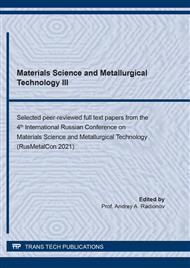[1]
A.Yu. Luchkin, O.A. Goncharova, I.A. Arkhipushkin, N.N. Andreev, Yu.I. Kuznetsov, The effect of oxide and adsorption layers formed in 5-Chlorobenzotriazole vapors on the corrosion resistance of copper, Journal of the Taiwan Institute of Chemical Engineers. 117 (2020) 231-241.
DOI: 10.1016/j.jtice.2020.12.005
Google Scholar
[2]
Yu.I. Kuznetsov, V.A. Karpov, N.N. Andreev, S.V. Oleynik, O.A. Goncharova, A.A. Chirkunov, Yu.A. Kuzenkov, A.Yu. Luchkin, A.M. Semiletov, N.G. Anufriev, V.N. Sereda, D.S. Mikurov, V.T. Nguyen, B.T. Fan, New methods of anticorrosive protection of metals under conditions of tropical climates. Part 1. Laboratory means selection and statement of samples, Corrosion: Materials, Protection. 5 (2020) 1-12.
DOI: 10.31044/1813-7016-2020-0-5-1-12
Google Scholar
[3]
D.E.J. Talbot, J.D.R. Talbot, Corrosion Science and Technology, CRC Press, Boca Raton, (2018).
Google Scholar
[4]
L.G. Kolyada, E.V. Tarasyuk, N.L. Kalugina, Technology of packing materials for metal products, Solid State Phenomena. 870 (2016) 454-459.
DOI: 10.4028/www.scientific.net/msf.870.454
Google Scholar
[5]
I.L. Rozenfel'd, V.P. Persiantseva, Atmospheric Corrosion Inhibitors, Nauka, Moscow, (1985).
Google Scholar
[6]
L.G. Kolyada, L.R. Salikhova, O.M. Katyushenko, Investigation of the protective properties of combined packaging materials, Vestnik of Nosov Magnitogorsk State Technical University. 1 (17) (2007) 110-113.
Google Scholar
[7]
L.G. Kolyada, E.V. Tarasyuk, A.P. Ponomarev, The research of service characteristics of up-to-date packaging material for metal products, Materials Science Forum. 989 (2020) 16-21.
DOI: 10.4028/www.scientific.net/msf.989.16
Google Scholar
[8]
N.L. Medyanik, I.V. Shadrunova, L.G. Kolyada, E.V. Tarasyuk, T.V. Chekushina, Anti-corrosive packing materials for metal products, Solid State Technology. 3 (63) (2020) 2614-2625.
Google Scholar
[9]
L.G. Kolyada, E.V. Tarasyuk, A.P. Ponomarev, V.R. Vafin, The analysis of the modern packaging materials for the metal products, Ferrous Metallurgy. Bulletin of Scientific, Technical and Economical Information. 6 (1410) (2017) 61-73.
Google Scholar
[10]
D. Brandon, W.D. Kaplan, Microstructural Characterization of Materials, second ed., John Wiley & Sons Ltd, Chichester, (2008).
Google Scholar
[11]
J.I. Goldstein, D.E. Newbury, J.R. Michael, N.W.M. Ritchie, J.H.J. Scott, D.C. Joy, Scanning Electron Microscopy and X-Ray Microanalysis, Springer, New York, (2018).
DOI: 10.1007/978-1-4939-6676-9
Google Scholar
[12]
R.F. Egerton, Physical Principles of Electron Microscopy: an Introduction to Transmission, Raster and Analytical Electron Microscopy, Tekhnosfera, Moscow, (2010).
Google Scholar
[13]
M.M. Krishtal (Ed.), Scanning Electron Microscopy and X-ray Microanalysis in Examples of Practical Application, Tekhnosfera, Moscow, (2009).
Google Scholar
[14]
N.V. Koptseva, E.M. Golubchik, Yu.Yu. Efimova, D.M. Chukin, M. Dabala, Electron microprobe analysis of nonmetallic inclusions in high-strength invar alloys obtained using various embodiments of deoxidization, Vestnik of Nosov Magnitogorsk State Technical University. 1 (49) (2015) 65-69.
DOI: 10.18503/1995-2732-2016-14-3-99-105
Google Scholar
[15]
M.E. Brown, Introduction to Thermal Analysis. Techniques and Applications, Kluwer Academic Publishers, Dordrecht, (2001).
Google Scholar
[16]
P.J. Haines, Principles of Thermal Analysis and Calorimetry, The Royal Society of Chemistry, Cambridge, (2002).
Google Scholar
[17]
E. Kaisersberger, S. Knappe H. Möhler, S. Rahner, TA for Polymer Engineering, Selb, (1994).
Google Scholar
[18]
B. Wunderlich, Thermal Analysis of Polymeric Materials, Springer-Verlag, Berlin, (2005).
Google Scholar
[19]
A.Kh. Kuptsov, G.N. Zhizhin, Fourier-Raman and Fourier-IR Spectra of Polymers, Tekhnosfera, Moscow, (2013).
Google Scholar
[20]
V.N. Alekseev, The Course of Qualitative Chemical Semi-Microanalysis, fifth ed., Khimiya, Moscow, (1973).
Google Scholar
[21]
L.I. Antropov, E.M. Makushin, V.F. Panasenko, Metal Corrosion Inhibitors, Tekhnika, Kiev, (1981).
Google Scholar


